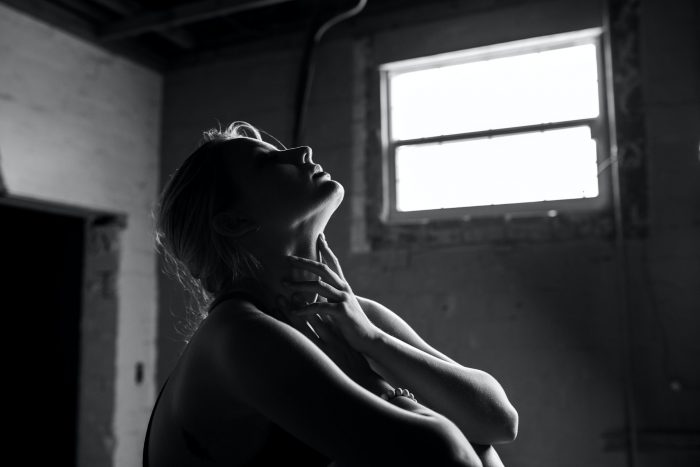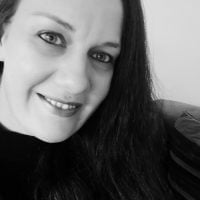I was sitting in an uncomfortable chair in a small room with a wooden, creaking floor, amongst a bunch of strangers.
The chairs were arranged in a circle. There was a table with two chairs in the middle of the room, small white candles burning, a stack of reading material, and the serenity prayer laminated and pasted on the floor:
“God grant me the serenity to accept the things I cannot change, the courage to change the things I can, and the wisdom to know the difference.”
I didn’t make eye contact with anyone for more than a second, and when I did, I smiled rather sheepishly. I might as well have walked in with a T-shirt that read, “Hi, I’m Mandy, and I’m carrying a world of shame because of this problem, and I don’t know if I should even be here.”
I remember reading something from Brené Brown, where she wrote of shame dying on exposure, but in this situation and my first time being there, I felt my shame grow the more I felt exposed. I don’t think I said more than 10 words in that meeting, and it was only to introduce myself.
I would later come to realize that my desire to hide, at that point, was still stronger than my desire to heal. I only took the first step of many on the road to recovery in order to heal what I believed was my broken spirit and my codependent behavior.
I was sitting in a Love Addicts Anonymous meeting.
I went through the ringer of personal relationships that always ended the same way—in turmoil and conflict. It was at the end of one particular relationship, with a person whom I believed was a predator, that the ugliest parts of myself were brought forth.
I felt lost in the wilderness of my soul, and for the first time in my life, I reached out and looked for help.
I shared a lot of stories—some with gut-wrenching heartache. Almost all of them held the answer that I spent most of my life trying to find: I was a love addict.
I consistently did only one thing through codependent behavior and betrayed my own heart. Love addiction holds us in a pattern of trying to change or fix people as a way to prove our worth.
I felt resistance to the word “codependency,” but as I attended more and more meetings, I discovered that even though the word evoked uncomfortable emotions, codependent behavior is not about who we are, it is about how we behave.
If we could choose codependency, we could choose another way, and that’s all we need to make changes—to believe in the possibility of another way.
That’s what kept me in my chair every Wednesday night for months. It’s what kept me sharing and opening up about the most vulnerable parts of myself. The warmth of that group made me feel less isolated, less shameful, and more accepted.
I was trapped in a cycle of only wanting to feel wanted, to be loved, and valued—a core need that I was using others to meet. Most of us who find ourselves in codependent relationships have a childhood history of neglect, abandonment, and the cycle of family addiction or abuse.
In the meeting, they told us that we weren’t allowed to take up space or have big feelings and destructive beliefs, such as:
>> I am responsible for how others feel, behave, or react.
>> If someone is angry or upset with me, it’s my fault, and I need to fix it.
>> My feelings are not as important as the feelings of others.
>> I need to bend over backward to make others feel more comfortable.
>> If someone treats me badly, it’s because I have done something wrong, and I need to try harder to win their approval.
At my first meeting, I had reached a point of mental, physical, and emotional exhaustion following the actions of my beliefs and being trapped in the cycle of codependency and pain. Much like a substance addict, I was addicted to what I believed was love. The beauty of hindsight and the often times I wanted to cry, “Me too!” in meetings led me to a place of self-awareness that I was never in before.
Each meeting brought with it a new insight, either from a shared experience or from someone who was successful in being able to rewire their core beliefs. In the chaotic world of love addiction, stability is almost non-existent, and to conquer my addiction, I had to accept these truths:
>> I am not responsible for the way other people feel, behave, or react.
>> People are allowed the freedom to have their own experience, and I don’t have to try to change it or fix it.
>> I can’t change someone else—I can only change myself and my behavior.
>> My worth is not determined by how much I give to others.
>> My boundaries deserve to be met and respected (I actually had to begin my journey with defining what my boundaries were).
>> If someone treats me badly, it is a reflection of their own self-worth, and I can walk away if it protects my energy.
Healing my love addiction and codependency meant devoting all my energy to myself—what I would once pour so freely into everyone else. To break the cycle, I set my boundaries, and most importantly, I began to honor them.
As expected, and as shared in the meetings, I lost relationships and friendships along the way, but I was no longer losing myself, and with time, I began to accept the truth and started living mine.
I learned the practice of self-care and self-soothing. I no longer clung to the external, and I cultivated the internal by spending time alone. I meditated and journaled, and I found—to my love addict’s surprise—how much I enjoyed the freedom of my own company.
A walk on the beach, reading just one more chapter before bed, meditating in my garden, and going to each meeting with more confidence about sharing with vulnerability, soothed my restless spirit.
My decision in that dark, hollow place was to find another way.
I reached out for help, and I found myself—not a broken, codependent person as I had always defined myself—but as a person who was learning to love herself more and more each day.
~
AUTHOR: AMANDA VAN GRAAN
IMAGE: KATE M/UNSPLASH


No comments:
Post a Comment